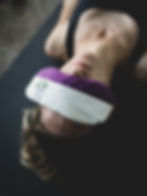
Restorative yoga is a wonderful practice for deep relaxation and rejuvenation. Whilst it may look a little like yin yoga there are differences, either way both restorative and yin compliment a yang practice.
Restorative Yoga:
- Postures and Duration: In restorative yoga, postures are held for often up to 10-20 minutes or even more.
- Breathing: Deep, nourishing breathing is a key component, helping to activate the relaxation response and calming the nervous system.
- Props: Props such as blankets, bolsters, blocks, and straps are commonly used to fully support the body in each posture, allowing for complete relaxation.
- Relaxation Response: By activating the parasympathetic nervous system, restorative yoga helps to slow the heart rate, increase blood flow to vital organs, and induce a state of deep relaxation.
- Benefits: It helps to reduce stress, release tension, balance the nervous system, and promote overall well-being.
Yin Yoga:
- Postures and Duration: Yin yoga also involves holding postures for an extended period, often 3-5 minutes or more.
- Focus: The focus in yin yoga is on deepening the stretch, targeting the connective tissues (ligaments, tendons, fascia) rather than the muscles.
- Benefits: Yin yoga can improve flexibility, increase circulation in the joints, and provide a meditative experience. It also helps to release fascia and improve the flow of energy (chi or prana) in the body.
Yang Yoga:
- Postures and Duration: Yang yoga includes more dynamic and active postures, moving through sequences with a focus on building strength, stamina, and flexibility.
- Examples: Vinyasa, Ashtanga, Power Yoga are examples of yang yoga.
- Benefits: Yang yoga helps to build muscular strength, endurance, and cardiovascular fitness. It's more physically challenging and can be a great complement to the more passive practices like yin and restorative yoga.
Complementary Practices:
- Restorative and Yin: Both focus on long holds, but restorative emphasises relaxation and support, while yin emphasizes deep stretching and releasing connective tissues.
- Yang and Restorative/Yin: Combining yang practices with restorative or yin can create a well-rounded yoga routine. Yang builds strength and flexibility, while restorative/yin provides deep relaxation and recovery.
Choosing the Practice:
- Stress Relief: For stress relief and deep relaxation, restorative yoga is excellent.
- Flexibility and Energy Flow: Yin yoga can be great for flexibility and energy flow.
- Strength and Stamina: Yang yoga is ideal for building strength, stamina, and flexibility.
- Combination: Many practitioners find benefits in combining these practices based on their needs. For example, a week might include a mix of yang classes for strength, yin for flexibility, and restorative for relaxation.
Incorporating a variety of yoga styles can offer a holistic approach to health and well-being, addressing different aspects of the body and mind. It's essential to listen to your body and choose the practice that suits your needs on any given day.
I teach hatha, vinyasa, hot, power, restorative and yin yoga, I also have specialist qualifications teaching yoga to athletes and those in sport and yoga for teenagers so please do contact me if you wish to know more or take a class with me either in a group or private session.
